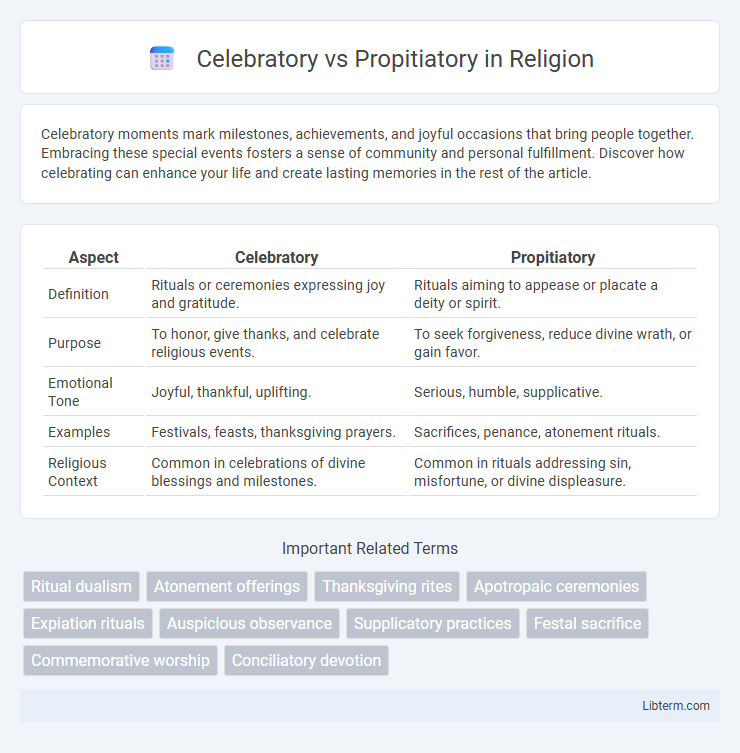Celebratory moments mark milestones, achievements, and joyful occasions that bring people together. Embracing these special events fosters a sense of community and personal fulfillment. Discover how celebrating can enhance your life and create lasting memories in the rest of the article.
Table of Comparison
| Aspect | Celebratory | Propitiatory |
|---|---|---|
| Definition | Rituals or ceremonies expressing joy and gratitude. | Rituals aiming to appease or placate a deity or spirit. |
| Purpose | To honor, give thanks, and celebrate religious events. | To seek forgiveness, reduce divine wrath, or gain favor. |
| Emotional Tone | Joyful, thankful, uplifting. | Serious, humble, supplicative. |
| Examples | Festivals, feasts, thanksgiving prayers. | Sacrifices, penance, atonement rituals. |
| Religious Context | Common in celebrations of divine blessings and milestones. | Common in rituals addressing sin, misfortune, or divine displeasure. |
Introduction to Celebratory and Propitiatory Practices
Celebratory practices involve rituals and activities that honor significant events, achievements, or deities, emphasizing joy, gratitude, and communal participation. Propitiatory practices, by contrast, focus on appeasing or pleasing a deity or spirit to avert misfortune, seeking forgiveness or favor through offerings and prayers. These two ritual types distinguish themselves by intent--one expressing celebration and thanks, the other aiming to restore harmony and avoid negative outcomes.
Defining Celebratory Rituals
Celebratory rituals encompass ceremonies and activities that honor significant life events, achievements, or cultural milestones, emphasizing joy, gratitude, and communal participation. These rituals often include festivals, weddings, and holidays where symbolic gestures, music, and shared meals reinforce social bonds and cultural identity. Defining celebratory rituals involves recognizing their role in marking positive transitions and fostering collective happiness within communities.
Understanding Propitiatory Ceremonies
Propitiatory ceremonies aim to appease deities or supernatural forces to avert misfortune and gain favor, often involving offerings, sacrifices, or rituals designed to restore balance and harmony. These ceremonies are deeply rooted in religious and cultural traditions, emphasizing the mitigation of divine wrath or displeasure rather than mere celebration. Understanding propitiatory practices reveals their role in maintaining social order, spiritual cleansing, and the reinforcement of communal beliefs in the power of ritual intervention.
Historical Origins of Celebratory vs Propitiatory Acts
Celebratory acts trace their historical origins to ancient rituals that marked communal victories, seasonal changes, and social milestones, often rooted in shared joy and cultural identity. Propitiatory acts emerged from early religious practices aimed at appeasing deities or spirits, seeking protection, favor, or forgiveness to restore harmony and prevent misfortune. These divergent traditions shaped numerous cultural ceremonies, with celebratory acts emphasizing gratitude and communal bonding, while propitiatory acts centered on ritual sacrifice and supplication.
Cultural Significance and Symbolism
Celebratory rituals emphasize joy, community bonding, and the marking of important life events or seasonal cycles, symbolizing gratitude, achievement, and renewal. Propitiatory rituals seek to appease deities or spirits, aiming to prevent misfortune or secure favor, reflecting deep cultural beliefs in supernatural influence and the balance between humans and the divine. Both types of rituals reveal underlying values and worldviews, highlighting how societies interpret and interact with the sacred through symbolic actions and offerings.
Similarities Between Celebratory and Propitiatory Traditions
Celebratory and propitiatory traditions both serve to establish a meaningful connection between participants and higher powers or communal values through ritualistic practices. Both types of traditions often involve symbolic offerings, communal gatherings, and prescribed ceremonies that reinforce collective identity and social cohesion. These shared elements highlight the role of ritual in expressing reverence, whether celebrating blessings or seeking favor.
Major Differences in Purpose and Expression
Celebratory rituals primarily aim to honor and rejoice significant events, fostering community unity and positive emotions through joyful expressions such as feasting, dancing, and public ceremonies. Propitiatory rituals seek to appease or gain favor from deities or supernatural forces, often involving sacrifices, prayers, or offerings to avert misfortune or secure blessings. The major difference lies in purpose: celebration emphasizes gratitude and happiness, while propitiation focuses on reconciliation and protection.
Global Examples of Celebratory Rituals
Celebratory rituals worldwide include festivals such as Brazil's Carnival, India's Diwali, and Japan's Cherry Blossom Festival, each marking cultural heritage through dance, light, and nature appreciation. These rituals foster community bonding and express joy, gratitude, or seasonal changes without seeking to appease deities or spirits. Celebratory events often involve music, food, and public gatherings that symbolize renewal, prosperity, or historical remembrance.
Notable Propitiatory Practices Around the World
Notable propitiatory practices around the world include the ancient Greek ritual of animal sacrifice to appease gods and prevent misfortune, as well as the Mayan bloodletting ceremonies designed to ensure agricultural fertility and divine favor. In Japan, Shinto ceremonies often involve offerings to kami spirits to maintain harmony and avert calamities. African traditional religions frequently use libations and offerings to ancestral spirits to secure protection and blessings for communities.
Modern Adaptations and Evolving Meanings
Modern adaptations of celebratory practices emphasize communal joy and personal milestones, reflecting contemporary values of inclusivity and individual achievement. Propitiatory rituals have evolved to symbolize psychological relief and reconciliation rather than literal appeasement of deities, aligning with secular and therapeutic contexts. Both forms have integrated digital technology, allowing virtual participation and global connectivity in traditional ceremonies.
Celebratory Infographic

 libterm.com
libterm.com